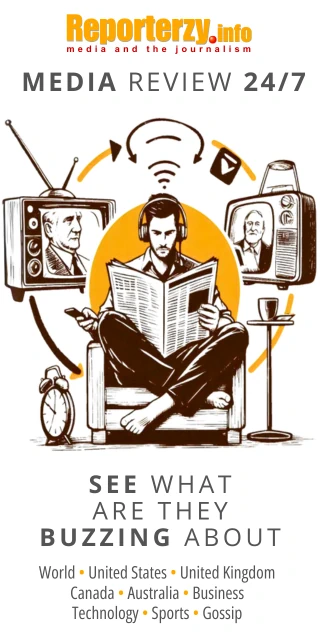 ilustracja: DALL-E
ilustracja: DALL-EData from the report “Audience trends television 2025” by the EBU Media Intelligence Service shows that television viewership in Europe continues to decline, although the pace of that decline has clearly slowed. The past five years have brought a slow but steady transformation of the market, shifting from the dominance of traditional television sets to new forms of video content consumption.
The television set is becoming a rare guest in the living room
In 2024, the average European spent 3 hours and 13 minutes per day watching television. That is 18 minutes less than five years ago, but only 3 minutes less than in 2023. This stabilisation after years of decline suggests that television, though in retreat, still has its place in viewers’ daily routines.
However, data on youth tells a different story. In 2024, people aged 15-24 watched television for an average of 1 hour and 13 minutes per day. That is 21 minutes less than five years earlier. Interestingly, compared to 2023, there was a symbolic increase of one minute.
| Year | Europeans (all) | Youth (15-24 years) |
|---|---|---|
| 2019 | 3h 31m | 1h 34m |
| 2020 | 3h 46m | 1h 40m |
| 2021 | 3h 35m | 1h 29m |
| 2022 | 3h 22m | 1h 18m |
| 2023 | 3h 16m | 1h 12m |
| 2024 | 3h 13m | 1h 13m |
Over five years, the number of countries where young people watch television for less than 30 minutes a day has risen from 0 to 10. This shows that new generations are choosing other ways to consume content, such as smartphones, VOD platforms and social media.
Weekly contact with television is becoming rare
Television still reaches the majority of Europeans. In 2024, 79% of the population had contact with it at least once a week. However, five years ago this figure was 85.5%. Among young people, the drop is even more noticeable, from 66.7% in 2019 to just 54% in 2024.
- In 2024, 18 European markets had weekly TV reach below 80% (in 2019, only 6).
- Among youth, in 17 countries reach fell below 50%, while five years earlier that was the case in only 2 countries.
Although weekly contact with television remains broad, both the number of viewers and their engagement and regularity are declining.
Live television still dominates
The vast majority of television watched in Europe is still live broadcasting. In 2024, 87% of adult viewing time was spent on real-time programming, and only 13% on time-shifted content. Among youth, the split was 84% and 16%, respectively.
It is worth noting that the number of markets where at least 20% of television time is time-shifted increased from 2 to 12 in five years. Among young people, this growth was even more significant, rising from 8 to 15 markets.
This shows that viewers, especially young ones, expect greater flexibility. They increasingly want to choose when and how to watch their favourite content.
Public broadcasters are fighting for young people`s attention
Although the overall condition of television is weakening, public broadcasters have reasons for cautious optimism. Their daily market share in 2024 averaged 23.4%, unchanged from 2019. Among youth, that share rose from 15.9% to 18.4%.
- 50% of main public channels are viewership leaders in their markets.
- In 84% of countries, public channels ranked among the 5 most-watched stations.
Meanwhile, weekly reach of public television fell to 53.8% (from 59.9% in 2019), and among youth to 25.5% (from 33.4%). This means that although those who choose to watch public channels do so more willingly and frequently, the overall number of viewers, especially young ones, continues to fall.
Rich programming offer but change is needed
Public broadcasters remain a force in producing quality content. On average, 5 of the 10 most-watched programmes per year in each country are public service media (PSM) productions. The most popular genres include:
- news and current affairs magazines,
- dramas and scripted series,
- entertainment shows and game shows,
- cultural and musical events,
- special broadcasts (e.g. national holidays).
However, this does not change the fact that changes in media consumption are advancing rapidly. Television is no longer the dominant medium, especially for young people. A growing priority is presence on digital platforms and tailoring content to audience expectations, with viewers unwilling to be limited by traditional schedules.
Television holds on thanks to older viewers
Viewership analysis by age group shows that behind the relative market stability lie two opposing trends. Seniors (60+) still spend a lot of time in front of the television, much more than younger viewers. This group keeps average viewing at a relatively steady level.
Meanwhile, people under 35 are turning to television less and less. This is not new, as young people have always watched less than older ones, but the gap is becoming increasingly stark. Public broadcasters must now ask themselves how to reach a generation growing up with TikTok, YouTube and Netflix.
***
The report "Audience trends television 2025" was prepared by the Media Intelligence Service team within the European Broadcasting Union (EBU). The analysis is based on official data from national television audience measurement systems (TAM) across 44 markets. It includes both live viewership and time-shifted viewing up to 7 days. The full report is available at ebu.ch
COMMERCIAL BREAK
New articles in section Media industry
Advertising market 2025. Poland, Europe and the World
Marcin Grządka
The global advertising market is growing by 8.8% in 2025 and will reach a value of 1.14 trillion dollars. The industry result in Europe records slightly lower dynamics, at the level of 5.8%. In this comparison, Poland performs clearly above the average. We will record an increase of 8.9% this year and a value of 18.56 billion PLN - estimates WPP Media in the annual report "This Year Next Year".
The print media market 2025. Three global trends
Krzysztof Fiedorek
The market value is 359.53 billion dollars, yet the erosion is visible to the naked eye. The decline for newspapers will amount to -2.3 percent. Despite this, print retains strength: it generates 76 percent of subscription revenues and enjoys 82 percent consumer trust. The future of the industry is defined by hybrid strategies and niche specialization.
Journalism in the age of AI. Why people prefer humans over machines
Krzysztof Fiedorek
Only 12% of people accept news created solely by AI, while 62% prefer those written by humans. At the same time, only 19% notice labels indicating the use of artificial intelligence, while younger audiences ask AI to explain the content to them. These are the findings of the Reuters Institute report on artificial intelligence in media.
See articles on a similar topic:
Radio, Streaming, and Podcasts. Total Audio 2024 Report about Poland
Krzysztof Fiedorek
Audio content is a daily companion for Poles. According to the Total Audio 2024 study conducted by Adres:Media on behalf of the Radio Research Committee, as many as 90% of respondents listen to audio content at least once a week, and 80% do so daily. The average listening time is nearly five hours per day.
E-commerce Forecasts in Poland. Trends for 2024 and Beyond
Krzysztof Fiedorek
In 2024, e-commerce in Poland is reaching new heights, with an increasing number of consumers regularly shopping online. The report "E-shopping Habits of Poles 2024," prepared by SAMOSEO analysts, analyzes current trends and forecasts the industry's near future.
Models of Journalistic Organizations
Zenon Kuczera
An overview, operational principles, and characteristics of journalistic organizations operating in Belgium, Canada, Switzerland, and the United States.
Poles on the Internet. RegionyNEXERY 2024 Report
KFi
The Internet not only connects people but also changes their daily habits in ways that seemed unattainable just a few years ago. Over 40% of Poles work remotely, and IoT devices are gaining popularity in rural areas. The #RegionyNEXERY 2024 report reveals surprising facts about the digital reality.






























